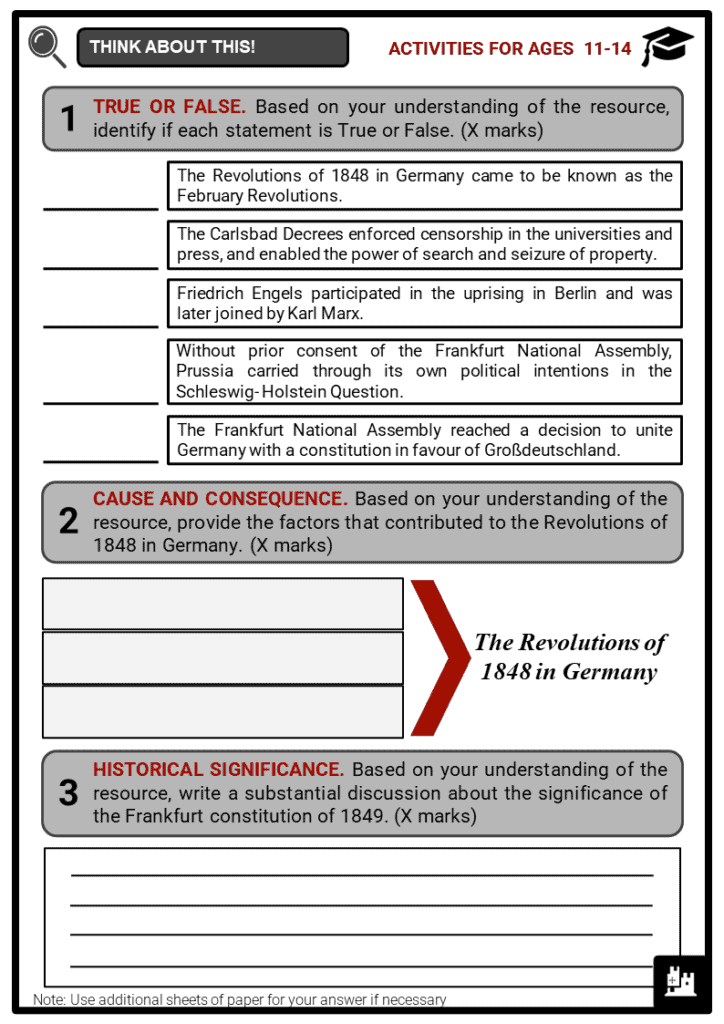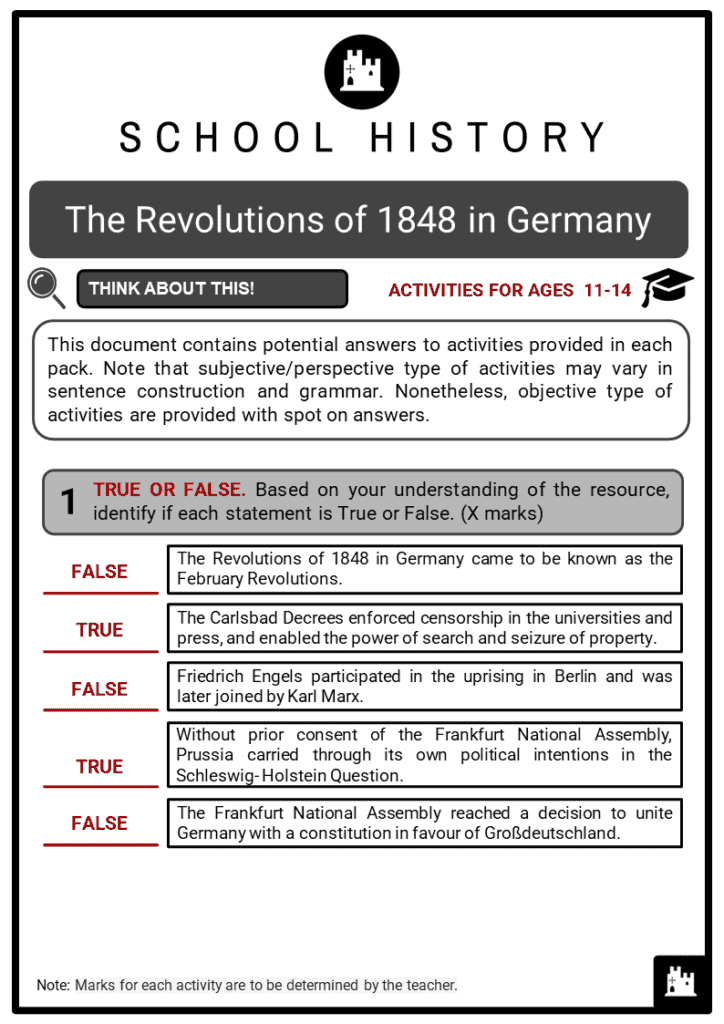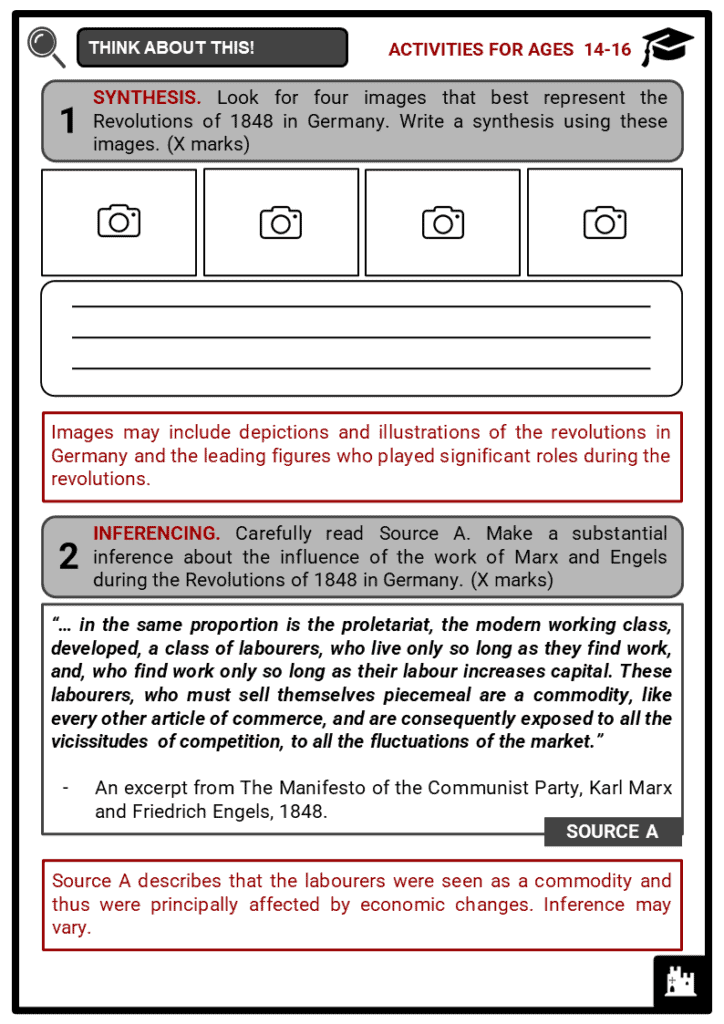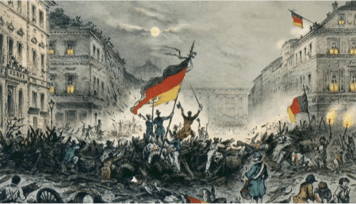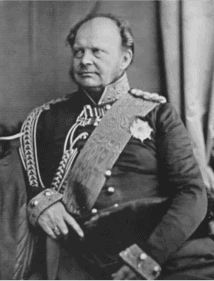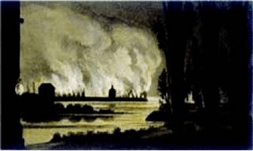Download The Revolutions of 1848 in Germany Worksheets
Do you want to save dozens of hours in time? Get your evenings and weekends back? Be able to teach The Revolutions of 1848 in Germany to your students?
Our worksheet bundle includes a fact file and printable worksheets and student activities. Perfect for both the classroom and homeschooling!
Table of Contents
Add a header to begin generating the table of contents
Summary
- Overview of the Revolutions of 1848
- Features of the Revolutions of 1848 in Germany
- The upsurge of uprisings in Germany
- Outcomes of the Revolutions of 1848 in Germany
Key Facts And Information
Let’s find out more about The Revolutions of 1848 in Germany!
- The Revolutions of 1848 in Germany were part of the widespread revolutionary wave that swept across Europe. Inspired by the early revolutionary victories in Paris and Vienna, revolts broke out in various German territories that generally demanded for reforms and the creation of a unified state. The conservative princes and rulers conceded to the revolutionary demands. A constitution was initially promised but then rejected by King Friedrich Wilhelm IV of Prussia.
- As the middle class and working class split, the conservative elites regained power and the early achievements of the revolutions were overturned. Though the revolution failed, it managed to lay the groundwork for the unification of Germany in the succeeding years.
Overview of the Revolutions of 1848
- In 1848 and early 1849, Europe witnessed its most widespread revolutionary wave now often referred to as the Springtime of Nations or the Year of Revolution. The increasingly radical widespread protests affected more than fifty countries with France, the states of the German Confederation, Italy, and the Austrian Empire having the most important revolutions. Whilst the uprisings had no significant coordination among their respective revolutionaries, they were brought about by similar contributing factors such as dissatisfaction with the poor governance and the negligence of the European monarchs towards the people, the emergence of new ideas such as nationalism, liberalism, and socialism in Europe, and the shared desire for reform of the middle and working classes. Most of the revolutions of 1848 generally failed and led to the conservatives regaining power. Nevertheless, they effectively catalysed significant reforms in various European states.
Features of the Revolutions of 1848 in Germany
- The Revolutions of 1848 in Germany that came to be known as the March Revolutions or Märzrevolution broke out because of certain events following the Napoleonic Era. The German states had emerged with a new consciousness and governmental structure owing to the influence of the ideas from the French Revolution and the Enlightenment.
- Established by the Congress of Vienna in 1815, the German Confederation of 35 princely states and 4 independent cities replaced the destroyed Holy Roman Empire. The Kingdom of Prussia and the Austrian Empire were the most powerful members of this confederation.
- What was the situation in Germany prior to 1848?
- Nationalists called for a unified Germany but this was made impossible by the King Friedrich Wilhelm IV of Prussia
- Klemens von Metternich influenced legislation within the confederation to crush liberalism.
- The Carlsbad Decrees enforced censorship in the universities and press, and enabled the power of search and seizure of property.
- The work of Karl Marx and Friedrich Engels, The Communist Manifesto, inspired the working class, which made up the majority of the population in the Germanic lands, to rise up.
- There was a tremendous growth in industries accompanied by a population explosion.
- The working class was struggling to survive and in many cases remained in poverty.
- Significant events that set off the unrest
- From 1846, there was a downward turn in the business cycle as many new businesses failed and many workers lost their jobs.
- A major harvest failure from 1845 to 1847 swept across Europe resulting in famine throughout the confederation.
- Aims of the revolutions
- Create a unified Germany.
- Establish a political democracy.
- Remove the conservative elite.
- The bourgeoisie wanted the economic benefits of capitalism and class rule over all society.
- The working class wanted to get out of poverty and use bourgeois democracy to move on to the next stage of social democracy.
The upsurge of uprisings in Germany
- When news of revolutionary victories in February 1848 in Paris broke, uprisings occurred in the German territories. These were further catalysed by the Viennese Revolution.
- Baden, one of the most liberal states in Germany, saw several unorganised instances of peasants burning the mansions of local aristocrats. On 27 February 1848, an assembly of people from Baden adopted a resolution demanding a bill of rights in Mannheim.
- Würtemberg, Hesse-Darmstadt, Nassau, and other German states followed suit and adopted similar resolutions. Since these movements had surprisingly strong popular support, rulers were forced to accept many of the Märzforderungen (demands of March) almost without resistance.
- Friedrich Engels participated in the uprising in the region and was later joined by Karl Marx. The two became editors of the Neue Rheinische Zeitung.
- In March in Prussia, crowds of people gathered in Berlin with most of the fighting done by the working class and the students.
- Berlin was noted as having bloody streets because of the fighting- barricades made of cobblestones turned the streets into fortresses. The demonstrators presented their demands to the king. Taken by surprise,King Friedrich Wilhelm IV submitted verbally to all the demonstrators’ demands, including parliamentary elections, a constitution, and freedom of the press. Additionally, he vowed that “Prussia will merge itself into Germany forthwith.”
- On 13 March, an altercation between the army and the demonstrators left one person dead and many injured. In another large demonstration that took place on 18 March, people erected barricades, and in response, troops were deployed leaving hundreds dead.
- The king reassured to reorganise his government and approved arming the citizens. A week after the riots, he attended the mass funeral for the civilian victims of the uprising and liberated and paraded the Polish political prisoners through the city to the acclaim of the people.
- The conservative princes and rulers of the various German states, fearing the fate of Louis Philippe of France, conceded in the demand for reform. Under the gaze of Germania – a painting dedicated to the national unity of Germany – national elections were quickly held in a parliament set to be located in
- The deputies of the Frankfurt National Assembly were in most part members of the middle class liberals, yet a larger percentage of them were academics. The Assembly met on 18 May with great excitement. It was tasked to draft a new constitution.
- Although the delegates were educated men, they had little political experience. Settling issues proved to be difficult which slowed down an already long process. It also did not help when the reputation of the Assembly was damaged because of two significant events:
- Without prior consent of the Assembly, Prussia carried through its own political intentions in the Schleswig-Holstein Question.
- Austria suppressed a popular uprising in Vienna by military force whilst the Assembly was in the process of drafting a new constitution.
- Delegate Robert Blum was on a fact-finding mission to see how Austria's government was reversing liberal achievements by military force. He took part in the street fighting, was arrested and executed in November, despite his claim to immunity from prosecution as a member of the National Assembly.
- The nationalist interest had been a root of endlessly debated topics in the Assembly such as whether to include Austria into the new Germany. Austria was a collection of many different ethnicities and the Assembly was concerned about the ten million ethnic Germans who lived there. Two factions emerged from this issue, the ones that supported Großdeutschland or Greater Germany, and the ones who opposed them, Kleindeutschland or Smaller Germany. Members of Großdeutschland wanted to include Austria with all the other ethnicities whilst members of Kleindeutschland wanted to include only Prussia together with the other 38 states of the German Confederation.
- The conservative elites and generals of Prussia were able to regain power in Berlin by late 1848.
- The revolts that started in March forced them to retreat but only temporarily. Once the conservatives recaptured Berlin in November, Friedrich Wilhelm IV rejoined them and dissolved the new Prussian parliament that had been recently elected in May.
- He then proclaimed a constitution of his own based upon the work of the Assembly, yet preserving the ultimate authority of the king. This constitution allowed for the formation of an upper house and a lower house that was selected by universal suffrage under a three-class system of voting.
- Meanwhile, after eleven months, the Frankfurt National Assembly reached a decision to unite Germany with a constitution in favour of Kleindeutschland under the rule of Friedrich Wilhelm IV. The middle class was not opposed to a monarchy and in fact, welcomed a Kaiser as long as its power would remain checked by a constitution and an elected assembly. They believed that a monarch was needed in order to successfully unite Germany.
- In April 1849, a delegation met with the king and offered him the crown of the Emperor under this new constitution. Friedrich Wilhelm IV initially claimed that he felt honoured but later declined this offer since it came from the hands of the common people. He would have accepted the crown if it came from the hands of his peers. Soon afterwards, he sent troops back into Berlin and ended the uprisings. The rest of the revolutions began to lose steam and sputter out. The working class provided little resistance to the return of the monarchy.
- Following the rejection of the Frankfurt constitution, Austria and Prussia withdrew their delegates from the Assembly. The remaining radical members were forced to go to Stuttgart, where they sat briefly as a rump parliament until it too was dissolved by Würtemberg troops.
- In other German states, especially in Saxony, the Palatinate and Baden,armed uprisings in support of the constitution continued but were short-lived. The local military dispersed them quickly.
- The revolutionaries, if caught, faced execution or long-term imprisonment. By July 1849, the Revolutions of 1849 in Germany were defeated by the Prussian troops.
Outcomes of the Revolutions of 1848 in Germany
- A series of factors accounted for the failure of the revolutions in Germany. The early achievements were reversed in the German states and after a few years, the hard work of the Frankfurt National Assembly was also revoked.
- Successes of the revolutions in Germany
- Although it did not last long, a provisional government was created in some German states.
- The Frankfurt National Assembly marked the first freely elected parliament for all of Germany.
- The remaining forms of agrarian feudalism were abolished across the German Confederation.
- Why did the revolutions fail in Germany?
- Factions in the Frankfurt National Assembly had conflicting interests.
- The democratic and liberal forces were challenged with the need to build a nation state and a constitution at the same time.
- King Friedrich Wilhelm IV of Prussia refused to accept the crown of the Emperor under the new constitution.
- The radicals failed to gain popular support.
- The monarchist forces were overwhelmingly superior.
- The idea of pan-Germanism was stressed in the revolutions but was not successfully accomplished. However, this managed to become a stepping stone in the unification of Germany that would happen in the succeeding years.
Image sources:
- https://upload.wikimedia.org/wikipedia/commons/thumb/b/b7/Maerz1848_berlin.jpg/400px-Maerz1848_berlin.jpg
- https://en.wikipedia.org/wiki/Frederick_William_IV_of_Prussia#/media/File:Friedrich_Wilhelm_IV_of_Prussia_(1847).jpg
- https://upload.wikimedia.org/wikipedia/commons/thumb/0/05/Ludwigshafen_brennt_1849_06_15_F_Artaria.jpg/220px-Ludwigshafen_brennt_1849_06_15_F_Artaria.jpg



